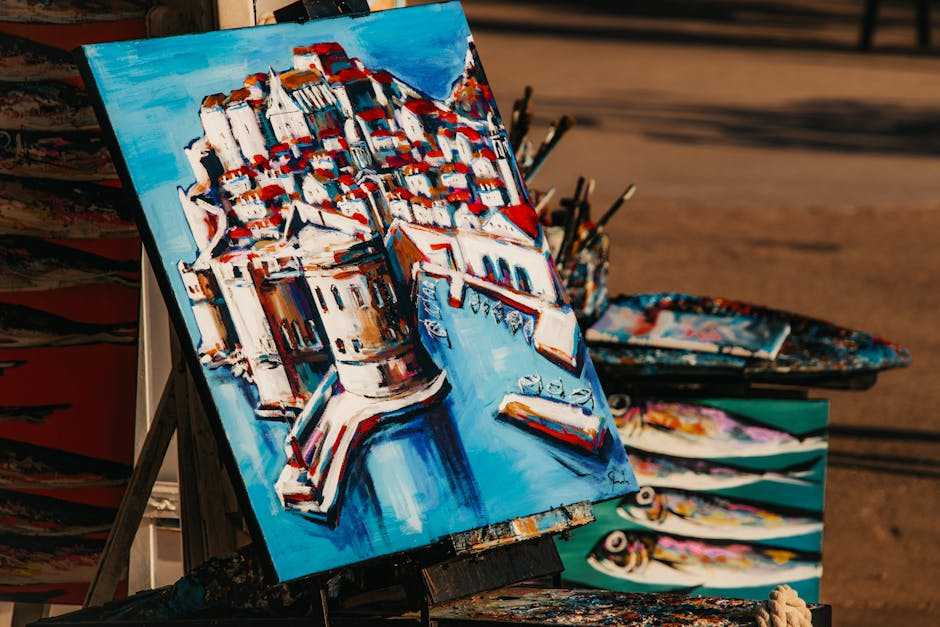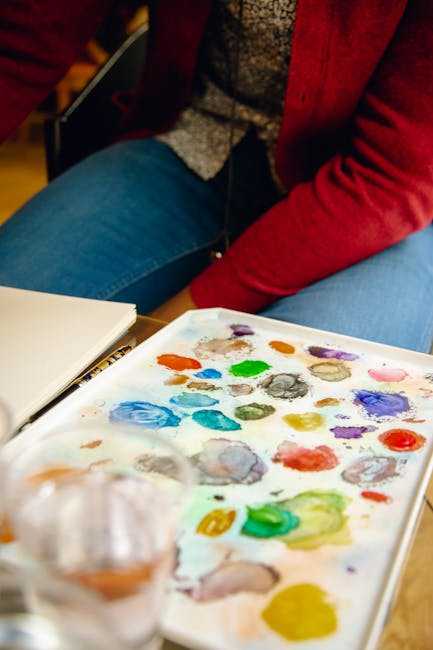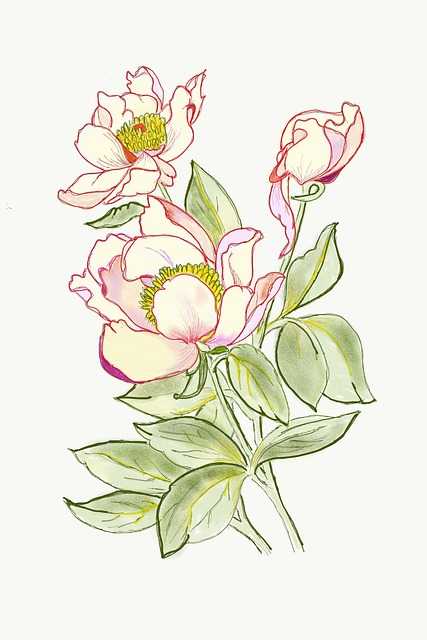Table of Contents
- Exploring the Rich History of Watercolor Art
- Essential Techniques to Master for Stunning Watercolor Painting
- A Comprehensive Guide to Choosing the Right Watercolor Supplies
- Tips for Creating Dynamic and Vibrant Watercolor Landscapes
- Q&A
- In Summary


Exploring the Rich History of Watercolor Art
Watercolor art, known for its fluidity and captivating hues, has a rich and intricate history that dates back centuries. Originating from ancient Egypt around 2500 BCE, watercolor techniques were initially employed for decorative purposes, often seen in murals and illuminated manuscripts. The medium evolved significantly through the ages, with artists exploring various substances and methods to enhance transparency and color vibrancy. By the time of the Renaissance, watercolor was recognized not merely as a tool for preliminary sketches, but rather as a standalone art form, celebrated for its unique ability to capture light and atmosphere.
During the 18th century, watercolor gained prominence in Europe, particularly among landscape painters who aimed to capture the beauty of nature. Artists like J.M.W. Turner and John Constable utilized watercolor to convey dramatic skies and serene landscapes, pushing the boundaries of the medium. The invention of portable watercolor sets provided artists with the opportunity to paint en plein air, creating spontaneous works that reflected their immediate reactions to their surroundings. This period marked a significant shift, as watercolor became an essential tool for artists seeking to express emotion and movement in their work.
The 19th century saw the establishment of watercolor societies, which encouraged artists to share their work and techniques. Prominent figures such as Winslow Homer and Georgia O’Keeffe popularized the medium in North America, showcasing its versatility in capturing everything from intricate details to sweeping vistas. It was during this time that the use of grains, paper textures, and layering became more sophisticated, leading to the emergence of various styles and approaches. Today’s watercolorists are inspired by their predecessors yet unbound by tradition, pushing innovative techniques that merge classic practices with modern concepts.
In contemporary art, watercolor continues to be redefined, encompassing a broad spectrum of styles from traditional to abstract. Many artists experiment with unconventional materials, such as ink or mixed media, enhancing the depth and narrative within their pieces. As galleries and online platforms showcase watercolor art, the appreciation for this medium flourishes, attracting both seasoned collectors and new enthusiasts alike. This enduring popularity underscores the timeless appeal of watercolor, a medium that effortlessly captures the essence of both nature and human experience.
Essential Techniques to Master for Stunning Watercolor Painting
Watercolor painting is an expressive medium that offers a wide range of techniques to explore. One essential skill every artist should master is the wet-on-wet technique. This involves applying wet paint on wet paper, allowing colors to blend and merge beautifully. To achieve stunning effects, be sure to control the amount of water you use. Too much can lead to muddy tones, while too little may cause unsightly hard edges. Experimenting with this technique can yield mesmerizing results that capture the fluidity of the medium.
Another fundamental technique is the dry brush method. This technique utilizes a brush with minimal water and pigment to create texture and detail. It’s perfect for rendering fine lines, intricate patterns, or adding depth to your painting. As you apply the paint to the dry surface, you’ll notice that the results can vary dramatically based on the type of paper and brush used. Make sure to practice on different surfaces to discover which combinations work best for your style.
Glazing is another powerful technique that involves applying thin, transparent layers of paint over dried layers. This method allows for rich color saturation and depth without overwhelming the underlying details. Begin by choosing a base layer that has dried completely, and then apply a new layer of a contrasting color. The result can be visually stunning, creating a luminous effect reminiscent of stained glass. Understanding color theory can enhance your glazing techniques, ensuring harmonious results that stand out.
Employing masking fluid is crucial for maintaining the brightest areas of your artwork. This liquid rubber temporarily protects parts of the paper from paint, allowing you to work freely without concern for preserving highlights. Once your painting is complete and dried, simply peel off the masking fluid to reveal pristine white areas beneath. Using this method can significantly elevate your piece by introducing a stark contrast against vibrant colors, enhancing the overall composition.


A Comprehensive Guide to Choosing the Right Watercolor Supplies
When diving into the world of watercolor painting, selecting the right supplies is essential for both beginners and experienced artists. Start with the watercolor paints. They come in two primary forms: tubes and pans. Tubes provide vibrant, rich colors that are easy to mix, while pans offer convenience and portability. Consider trying a brand known for high pigmentation and lightfastness to ensure your artworks stand the test of time. Popular choices among artists include Winsor & Newton, Daniel Smith, and Schmincke.
Next, the choice of brushes significantly impacts your painting experience. Look for brushes made from a mix of synthetic and natural fibers. Common shapes include round, flat, and mop brushes, each serving a unique purpose in creating different textures and effects. A good rule of thumb is to start with a couple of versatile brushes, such as a size 10 round and a flat, to help facilitate various techniques without overwhelming yourself with options.
Paper can make or break a watercolor piece. Quality watercolor paper is designed to handle the amount of water used in this medium without warping. Choose between hot-pressed (smooth), cold-pressed (textured), and rough finishes based on the desired outcome of your work. Here’s a simple comparison of the types that might help you decide:
| Type | Texture | Best For |
|---|---|---|
| Hot-Pressed | Smooth | Detail work and fine lines |
| Cold-Pressed | Textured | General painting and washes |
| Rough | Very textured | Bold strokes and textures |
don’t overlook the importance of additional tools such as masks, sponges, and palettes. A masking fluid can preserve white spaces in your work, while a well-organized palette allows for efficient mixing. Additionally, having sponges handy can help you create interesting textures and backgrounds. Investing in a few essential accessories can enhance your overall watercolor experience, making the art of painting both enjoyable and effective.


Tips for Creating Dynamic and Vibrant Watercolor Landscapes
When embarking on the journey of creating captivating watercolor landscapes, the first tip is to embrace spontaneity. Watercolors are inherently unpredictable, which is part of their charm. Allow the paint and water to interact naturally on the paper, creating unexpected textures and blends. A technique known as ”wet-on-wet,” where wet paint is applied to wet paper, can yield beautiful effects, such as soft edges and gentle gradients, ideal for skies and distant mountains.
Next, focus on layering and glazing to build depth in your landscapes. Begin with light washes for the base colors, and as each layer dries, gradually increase the intensity of your hues. This method not only enhances the vibrancy of your painting but also creates a sense of dimension. Remember to use transparent colors for glazing; it allows underlying layers to shine through, enriching the overall appearance. Here’s a quick reference for typical layering techniques:
| Layer Type | Color Application | Recommended Colors |
|---|---|---|
| Background Wash | Large, even strokes | Light Blue, Pale Yellow |
| Midground Elements | Soft, blended edges | Green, Lavender |
| Foreground Details | Defined brush strokes | Deep Green, Rich Brown |
Another essential element is the use of contrast—both in color and texture. Incorporating dark shades against lighter ones can draw attention to focal points within your landscape. Varying the brushwork, such as using a fine brush for detailed features like tree branches and a larger brush for broader strokes, will further enhance this visual interest. Adding elements like rough textures in rocks or smooth washes in water can also create dynamic interplay on the canvas.
Lastly, don’t forget to pay attention to the composition. A well-balanced painting often leads the viewer’s eye through the scene. Use the rule of thirds as a guide, positioning key elements along the grid lines or their intersections. Experiment with foreground, midground, and background elements that guide the viewer’s gaze towards a focal point. Consider including leading lines, such as winding paths or rivers, that naturally draw attention to specific areas, creating a more immersive experience in your artwork.
Q&A
Q&A: Exploring the World of Watercolor Art
Q: What are watercolors, and how do they differ from other painting mediums? A: Watercolors are a transparent painting medium made from pigments suspended in a water-soluble binder, usually gum arabic. Unlike oils or acrylics, watercolors are known for their fluidity and ability to create soft, delicate washes of color. This transparency allows for layering, creating depth and luminosity that can be quite challenging to achieve with other mediums.Q: What are the basic materials needed to start painting with watercolors? A: To begin your watercolor journey, you’ll need a few essential materials:
- Watercolor Paints: Available in tubes or pans, choose quality paints for better pigmentation.
- Watercolor Paper: Specially designed to handle moisture without warping, it comes in various weights and textures.
- Brushes: A selection of round and flat brushes in different sizes will provide versatility for your techniques.
- Water Container: For rinsing your brushes and mixing your paints.
- Palette: A surface for mixing colors to create your desired shades.
Q: What techniques should beginners learn when starting with watercolors? A: Beginners should familiarize themselves with several fundamental techniques, including:
- Wet-on-Wet: Applying wet paint onto wet paper for soft blends.
- Wet-on-Dry: Adding wet paint to dry paper for defined edges.
- Layering: Applying multiple transparent washes to build depth.
- Dry Brush: Using a dry brush to create texture and fine details.
- Lifting: Removing paint while it’s still wet or using a damp brush to soften edges.
Q: How can I improve my watercolor skills? A: Improving your watercolor skills takes practice and experimentation. Here are a few tips:
- Practice Regularly: Dedicate time to paint each week.
- Study Color Theory: Understanding how colors interact can enhance your compositions.
- Take Classes or Tutorials: Learn from experienced artists through online courses or local workshops.
- Experiment with Styles: Don’t hesitate to try different subjects, from landscapes to abstract forms. Each will teach you something new.
Q: Why do many artists choose watercolor as their primary medium? A: Many artists are drawn to watercolor for its unique qualities, such as portability and ease of cleanup. The unpredictable nature of watercolors often yields surprising results, fostering creativity and spontaneity. Additionally, its luminous qualities can evoke emotions and atmospheres that resonate deeply with viewers.
Q: Can watercolors be used for professional projects? A: Absolutely! Watercolors can be employed in various professional fields, including illustration, graphic design, and fine art. Many artists create stunning portfolios with watercolors, and they can be used in digital formats by scanning traditional paintings or creating digital versions. With the right techniques, watercolors can result in highly detailed and professional-grade artwork.
Q: What mistakes should beginners avoid when starting with watercolors? A: Common mistakes to avoid include:
- Using Too Much Water: Balancing water and pigment is essential; too much can lead to muddy colors.
- Overworking the Paper: Once a wash is applied, resist the urge to keep adding paint, as it can damage the paper.
- Neglecting Proper Paper: Using the wrong paper can ruin your painting experience—opt for good quality watercolor paper from the start.
- Skipping Planning: Sketching your composition lightly can help guide your painting process and make the execution smoother.
This Q&A aims to illuminate the enchanting world of watercolors, unraveling the mysteries of this versatile medium, while inspiring both new and experienced artists alike. Whether you’re picking up a paintbrush for the first time or brushing up on your skills, the world of watercolor has a vibrant palette waiting for you to explore.
